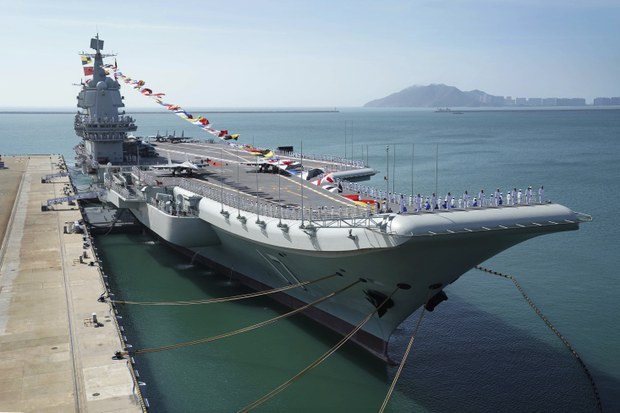China’s navy stages combat exercise in South China Sea
Share

The Shandong aircraft carrier, seen docked at a naval port in Sanya in southern China’s Hainan Province on Dec. 17, 2019.
China’s People’s Liberation Army (PLA) has held a number of live-fire drills, including a “confrontational exercise” by the Shandong aircraft carrier group, in the South China Sea as a U.S. carrier operates in the area.
The U.S. Indo-Pacific Command said in a statement that a strike group led by the aircraft carrier USS Nimitz has been in the South China Sea since last week and conducted “maritime strike training, anti-submarine operations, integrated multi-domain and joint training between surface and air elements, and flight operations with fixed and rotary wing aircraft.”
The Nimitz is accompanied by a guided missile cruiser and three guided missile destroyers including the USS Chung Hoon that made a Taiwan Strait transit on Jan. 5, angering China.
This is the carrier strike group’s first 2022-2023 South China Sea deployment.
Soon after the U.S. strike group made its entrance, the PLA Navy conducted a series of drills in the South China Sea, including a “combat exercise” by the Shandong aircraft carrier group.
The Shandong is China’s second aircraft carrier and the first wholly designed and built in the country. It is accompanied by four guided-missile destroyers.
The China Daily said the drills, carried out in both day and night time, involved warships, aircraft and submarines.
Another media outlet, the Global Times, said they were “realistic combat-oriented confrontational exercises” and simulated hostile aircraft attacks.
It said the Nimitz carrier strike group had “only stirred up tensions and had limited military significance.”
Show of power
China currently operates two aircraft carriers – the Shandong and the Liaoning. A third carrier named Fujian is expected to enter service in the near future.
The United States Navy, the world’s largest and most powerful naval force, has 11 active-duty aircraft carriers, all nuclear-powered.
“The Nimitz Carrier Strike Group has the capability to deliver integrated lethal and non-lethal effects from space to undersea, across every axis, and every domain,” Rear Adm. Christopher Sweeney, the strike group’s commander, was quoted as saying.
The strike group “demonstrates the ability to deliver overwhelming maritime force if called upon” and “remains committed to protecting the rights, freedoms, and lawful uses of the sea, and upholding the rules-based international order alongside Allies and partners,” he added.
The South China Sea, claimed by six parties including China, serves as one of the busiest waterways in the world. Beijing claims “historical rights” to most of the sea but its claims were rejected by regional countries and a U.N. tribunal.
The U.S. 7th Fleet has been conducting routine freedom of navigation (FONOP) operations in the area despite China’s protests.
Besides the exercise by the Shandong carrier group, the PLA Southern Theater Command has also held at least two live-fire drills in the South China Sea, according to Chinese military sources.
The PLA Daily said on its Weibo account that a “frigate detachment” from the Command in mid-January carried out “formation movement, air defense and anti-missile, anti-terrorism and anti-piracy [exercises], and light weapon shooting to sharpen their actual combat skills.”
Another recent exercise focused on combat support was held by the same Southern Theater Command, the China Broadcasting Network Military Channel said without giving the date. This time, the PLA warships conducted “maritime replenishment, joint search and rescue, and carrier-based helicopter take-off and landing,” suggesting it was carried out in coordination with the Shandong aircraft carrier group.
The Southern Theater Command is one of the PLA’s five major theaters commands and its primary area of responsibility is the South China Sea.
The U.S military alleged that it may also play a role in supporting another command, the Eastern Theater Command, in “any major amphibious operation against Taiwan.”







